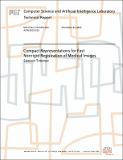| dc.description.abstract | We develop efficient techniques for the non-rigid registration of medical
images by using representations that adapt to the anatomy found in such
images.
Images of anatomical structures typically have uniform intensity interiors
and smooth boundaries. We create methods to represent such regions
compactly using tetrahedra. Unlike voxel-based representations, tetrahedra
can accurately describe the expected smooth surfaces of medical
objects. Furthermore, the interior of such objects can be represented using
a small number of tetrahedra. Rather than describing a medical object using
tens of thousands of voxels, our representations generally contain only a few
thousand elements.
Tetrahedra facilitate the creation of efficient non-rigid registration
algorithms based on finite element methods (FEM). We create a fast,
FEM-based method to non-rigidly register segmented anatomical structures
from two subjects. Using our compact tetrahedral representations, this
method generally requires less than one minute of processing time on a desktop
PC.
We also create a novel method for the non-rigid registration of gray scale
images. To facilitate a fast method, we create a tetrahedral representation
of a displacement field that automatically adapts to both the anatomy in an
image and to the displacement field. The resulting algorithm has a
computational cost that is dominated by the number of nodes in the mesh
(about 10,000), rather than the number of voxels in an image (nearly
10,000,000). For many non-rigid registration problems, we can find a
transformation from one image to another in five minutes. This speed is
important as it allows use of the algorithm during surgery.
We apply our algorithms to find correlations between the shape of
anatomical structures and the presence of schizophrenia. We show that a
study based on our representations outperforms studies based on other
representations. We also use the results of our non-rigid registration
algorithm as the basis of a segmentation algorithm. That algorithm also
outperforms other methods in our tests, producing smoother segmentations
and more accurately reproducing manual segmentations. | |

